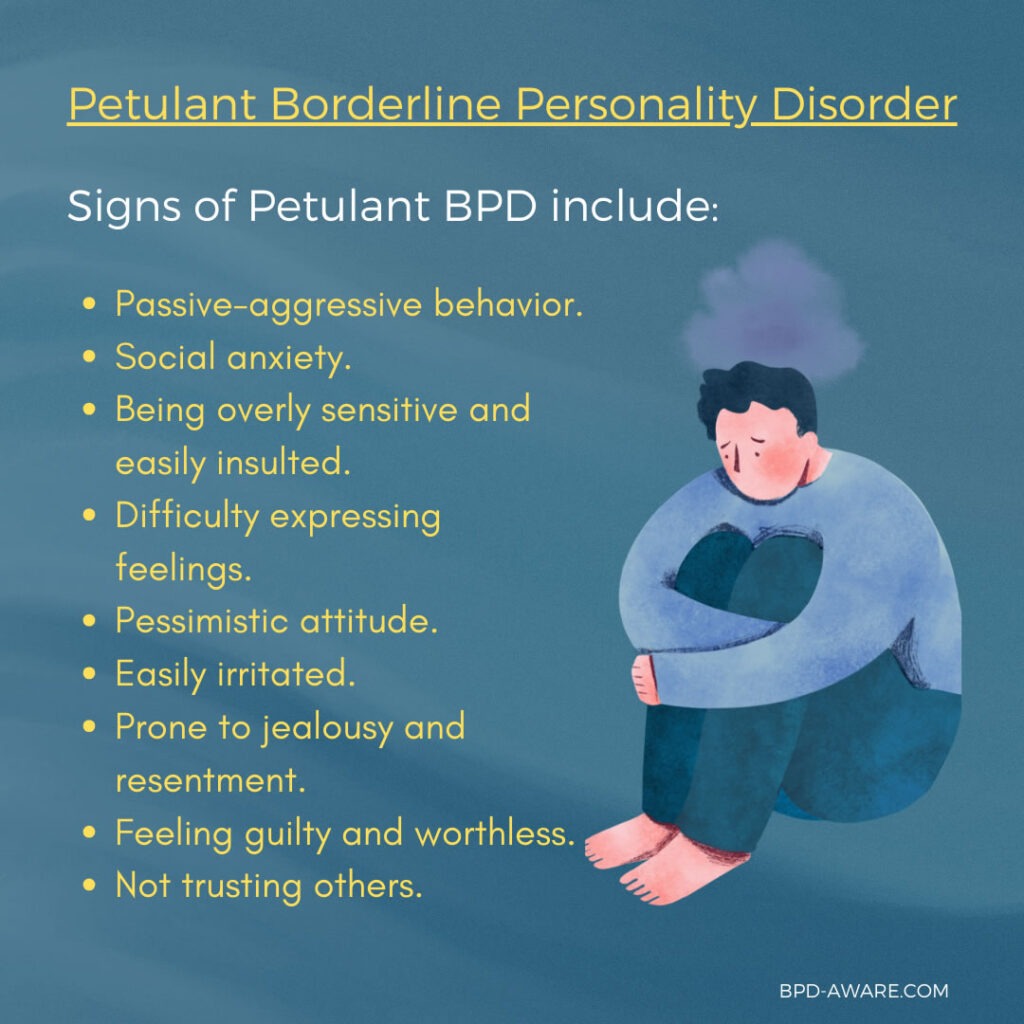Petulant Borderline Personality Disorder (BPD) is one of the four BPD subtypes, along with Discouraged BPD, Impulsive BPD, and Self-Destructive BPD. Someone with BPD can fit into one or more of the four subtypes at any one time. Similarly, it’s not uncommon to shift between types at various stages.
Sufferers of petulant Borderline Personality Disorder will experience many of the general symptoms of BPD, as well as some symptoms that are more unique to this specific subtype. As the name suggests, those with Petulant Borderline Personality Disorder often engage in patterns of petulant behavior such as passive-aggressiveness and feelings of jealousy.
What Are the Signs and Symptoms of Petulant Borderline Personality Disorder?
- Passive-aggressive behavior.
- Socially anxious.
- Overly sensitive/easily insulted.
- Struggle to express feelings.
- Pessimistic.
- Easily irritated.
- Prone to jealousy and resentment.
- Feeling guilty and worthless.
- Not trusting of others.
Problems Faced By People with Petulant BPD
The symptoms of Petulant BPD make it very difficult for sufferers to maintain healthy friendships and romantic relationships. Passive-aggressiveness and pessimism often drive people away, making the sufferer feel vindicated in never truly trusting them in the first place. This leads to a cycle of unbalanced relationships built on shaky foundations that are ultimately doomed to fail.
Therapy can also be harder for people with petulant BPD as they struggle to trust people, making it difficult to form a bond with a therapist.

Treating Petulant BPD
While there isn’t a cure for borderline personality disorder, treatment can help sufferers greatly improve their lives.
Medication can help reduce specific symptoms such as social anxiety and depression. While therapy provides the tools necessary to escape negative thought patterns.
The main two kinds of therapy used to treat Borderline Personality Disorder are Dialectical Behavior Therapy (DBT) and Cognitive Behavioral Therapy (CBT).
DBT helps teach a person how to improve their interpersonal skills and strengthen their relationships. It will also help with mindfulness, emotional regulation, and tolerance of distress. CBT aids with re-framing negative thought patterns and turning them into positive actions.
Together, these two forms of therapy are considered the gold standard in treating Borderline Personality Disorder.
Personal Accounts of Living With Petulant BPD
“Someone being ten minutes late to lunch can trigger me in a major way. My mind races away with me. Why are they late? Don’t they like me anymore? Do they prefer to spend their time with someone else? Am I ever going to see them again? Do they hate me? Even at the time there’s part of me that realizes how ridiculous my reaction is but that’s just how I feel.” – S Hopkins.
“Socializing makes me incredibly anxious even though I get along well with most people. I try and avoid it whenever possible but then I start to feel lonely and resentful that everyone else seems to have a partner and a close group of friends and I have none of that. It just makes me feel like something is intrinsically wrong with me.” – D Wilson.
“Therapy has helped me so much in being able to express myself constructively. I used to bottle it all up inside and just let it gnaw away at me until I exploded over the tiniest little thing. It was very much a case of the straw that broke the camel’s back. I’m so much better now though at communicating when something is bothering me and why and it feels like a load has been lifted.” – D Schneider.
Sources, Resources, and Further Reading
- What Is Petulant BPD? https://mypsychiatrist.com/blog/what-is-petulant-bpd/
- Petulant BPD: The Misunderstood Subtype You Need to Know: https://theprivatetherapyclinic.co.uk/blog/petulant-bpd/
- Understanding Petulant BPD: https://momentofclarity.com/borderline-personality-disorder-treatment/petulant-bpd/
- Petulant BPD: Symptoms, Causes, Treatment: https://www.talkspace.com/mental-health/conditions/borderline-personality-disorder/types/petulant-bpd/
















